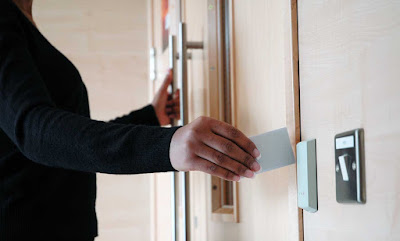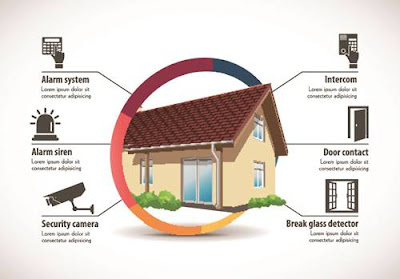Access Control Locking Devices
Door Access Control Locking Devices
In all locking systems, the locking device represents the physical security barrier. Locking devices include Magnetic Locks (Maglocks), Electric strikes, Deadbolts, Magnetic Shear Locks and Electrified Locksets. These devices are mounted on the door and door casing. Examples of Locking Device types follow. 'Clicking' on any of the device photos will open a new window with direct access to pricing, and product datasheets for further and more detailed reference.
Magnetic Locks
Magnetic lock electromagnetic lock, magnetic lock, or maglock is a locking device that consists of an electromagnet and armature plate. By attaching the electromagnet to the door frame and the armature plate to the door, a current passing through the electromagnet attracts the armature plate holding the door shut. Unlike an electric strike a magnetic lock has no interconnecting parts and is, therefore, less suitable for super high-security applications because it is possible to bypass the lock by disrupting the power supply.
Nevertheless, the strength of today's magnetic locks compares well above that of conventional door locks and they cost less than conventional light bulbs to operate. Power supplies incorporating a trickle-charged lead-acid battery pack should be used to retain security for short-term power outages. Magnetic locks possess a number of advantages over conventional locks and electric strikes. For example, their durability and quick operation can make them valuable in a high-traffic office environment where electronic authentication is necessary.
Magnetic lock electromagnetic lock, magnetic lock, or maglock is a locking device that consists of an electromagnet and armature plate. By attaching the electromagnet to the door frame and the armature plate to the door, a current passing through the electromagnet attracts the armature plate holding the door shut. Unlike an electric strike a magnetic lock has no interconnecting parts and is, therefore, less suitable for super high-security applications because it is possible to bypass the lock by disrupting the power supply.
Nevertheless, the strength of today's magnetic locks compares well above that of conventional door locks and they cost less than conventional light bulbs to operate. Power supplies incorporating a trickle-charged lead-acid battery pack should be used to retain security for short-term power outages. Magnetic locks possess a number of advantages over conventional locks and electric strikes. For example, their durability and quick operation can make them valuable in a high-traffic office environment where electronic authentication is necessary.
Advantages
- Easy to install: Magnetic locks are generally easier to install than other locks given there are no interconnecting parts.
- Quick to operate: Magnetic locks unlock instantly when the power is cut allowing for quick operation in comparison to other locks.
- Suffer less damage: Magnetic locks may also suffer less damage from multiple blows than conventional locks.
Disadvantages
- Requires continuous power: To remain locked, the magnetic lock requires a constant power source. The power drain of the lock is typically around 3 watts, far less than that of a conventional light bulb (around 60 watts), but it may cause security concerns as the device will become unlocked if the power source is disrupted. In comparison, electric strikes can be designed to remain locked should the power source be disrupted. Nevertheless, this behavior may actually be preferable in terms of fire safety.
Electric Strikes
Replaces the fixed strike faceplate often used with a latch bar (also known as a keeper). Like a fixed strike, it normally presents a ramped surface to the locking latch allowing the door to close and latch just like a fixed strike would. However, an electric strikes ramped surface can, upon command, pivot out of the way of the latch allowing the door to be pushed open (from the outside) without the latch being retracted (that is, without any operation of the knob) or while excited the knob or lever can be turned to allow egress from the secured area. Electric strikes generally come in two basic configurations:
Fail-secure
- Also called fail-locked or non-fail safe. In this configuration, applying electric current to the strike will cause it to open. In this configuration, the strike would remain locked in a power failure, but typically the knob can still be used to open the door from the inside for egress from the secure side. These units can be powered by AC which will cause the unit to "buzz", or DC power which will offer silent operation, except for a "click" while the unit releases.
Fail-safe
- Also called fail-open. In this configuration, applying electric current to the strike will cause it to lock. In this configuration, it operates the same as a magnetic lock would. If there is a power failure, the door would open merely by being pushed/pulled open. Fail safe units are always run using DC power.
Electric Deadbolts
are recommended for high-security interior door and cabinet applications where electromagnetic locks are not required. Electric bolt locks include long life solenoid driven direct throw mortise bolts, some models offer right angle bolts for narrow frames and door styles and surface mounted bolt locks for door and cabinet applications. Compatible with virtually any access control system, electromechanical bolt locks are available in fail safe and fail secure modes
Magnetic Shear Locks
are recommended to provide superior fail-safe holding force and aesthetics for most types of doors, including high profile frameless glass doors. Representing the latest evolution in the development of magnetic locks, shear locks incorporate several features to ensure that the door seamlessly locks and releases without hindrance.Electrified Locksets
look and function like a typical cylindrical or mortise style mechanical lock. However, incorporate internal solenoids to enable the lock and latch feature. Building and fire life safety code compliant for fire rated office doors, corridor doors, lobby doors, exit doors and stairwell doors. Whether fail safe or fail secure, controlled access and remote control capability are provided while the door stays latched even when unlocked, maintaining fire door integrity.
For more information about access control system, please visit my "ShineACS Access Control Security" main website--It is a FREE website that you can download access control system knowledge and find right suitable access control products and solutions for your access control project.




Comments
Post a Comment